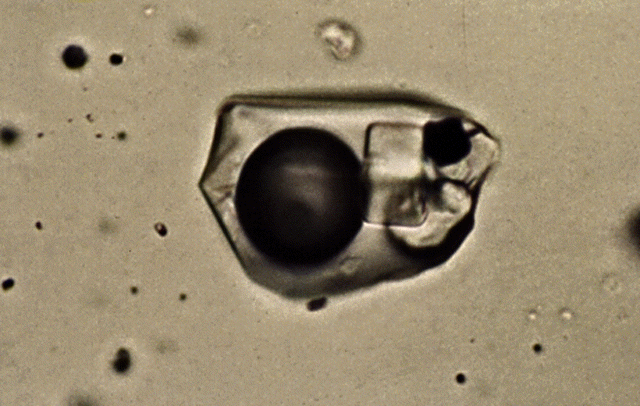Enhydro agate on:
[Wikipedia]
[Google]
[Amazon]
 Enhydro agates are nodules,
Enhydro agates are nodules,

 Enhydros are formed when water rich in
Enhydros are formed when water rich in
Enhydros, Fluid Inclusions, The Phases, & More Enhydro Data
Agates {{geology-stub
 Enhydro agates are nodules,
Enhydro agates are nodules, agate
Agate () is a common rock formation, consisting of chalcedony and quartz as its primary components, with a wide variety of colors. Agates are primarily formed within volcanic and metamorphic rocks. The ornamental use of agate was common in Anci ...
s, or geode
A geode (; ) is a geological secondary formation within sedimentary and volcanic rocks. Geodes are hollow, vaguely spherical rocks, in which masses of mineral matter (which may include crystals) are secluded. The crystals are formed by the fill ...
s with water trapped inside its cavity. Enhydros are closely related to fluid inclusions image:Inclumed.gif, 250px, Trapped in a time capsule the same size as the diameter of a human hair, the ore-forming liquid in this inclusion was so hot and contained so much dissolved solids that when it cooled, crystals of halite, sylvite, gypsum, ...
, but are composed of chalcedony
Chalcedony ( , or ) is a cryptocrystalline form of silica, composed of very fine intergrowths of quartz and moganite. These are both silica minerals, but they differ in that quartz has a trigonal crystal structure, while moganite is monocli ...
. The formation of enhydros is still an ongoing process, with specimens dated back to the Eocene Epoch
The Eocene ( ) Epoch is a geological epoch that lasted from about 56 to 33.9 million years ago (mya). It is the second epoch of the Paleogene Period in the modern Cenozoic Era. The name ''Eocene'' comes from the Ancient Greek (''ēṓs'', "daw ...
. They are commonly found in areas with volcanic rock.
Description
Enhydroagate
Agate () is a common rock formation, consisting of chalcedony and quartz as its primary components, with a wide variety of colors. Agates are primarily formed within volcanic and metamorphic rocks. The ornamental use of agate was common in Anci ...
s are made up of banded microcrystalline
A microcrystalline material is a crystallized substance or rock that contains small crystals visible only through microscopic examination. There is little agreement on the range of crystal sizes that should be regarded as microcrystalline, but th ...
or cryptocrystalline
Cryptocrystalline is a rock texture made up of such minute crystals that its crystalline nature is only vaguely revealed even microscopically in thin section by transmitted polarized light. Among the sedimentary rocks, chert and flint are crypt ...
quartz
Quartz is a hard, crystalline mineral composed of silica ( silicon dioxide). The atoms are linked in a continuous framework of SiO4 silicon-oxygen tetrahedra, with each oxygen being shared between two tetrahedra, giving an overall chemical ...
. The agate has a hollow center, partially containing water. Enhydro agates can also contain debris or petroleum
Petroleum, also known as crude oil, or simply oil, is a naturally occurring yellowish-black liquid mixture of mainly hydrocarbons, and is found in geological formations. The name ''petroleum'' covers both naturally occurring unprocessed crud ...
. Because the cavity is not full, the agate can produce sound from being shaken. Agates vary in size. The largest recorded agate was found in Fuxin City, China, with a diameter of 63 cm (24.8 in) and weighing 310 kg (683 lbs).
Formation

 Enhydros are formed when water rich in
Enhydros are formed when water rich in silica
Silicon dioxide, also known as silica, is an oxide of silicon with the chemical formula , most commonly found in nature as quartz and in various living organisms. In many parts of the world, silica is the major constituent of sand. Silica is ...
percolates through volcanic rock, forming layers of deposited mineral
In geology and mineralogy, a mineral or mineral species is, broadly speaking, a solid chemical compound with a fairly well-defined chemical composition and a specific crystal structure that occurs naturally in pure form.John P. Rafferty, ed. (2 ...
. As layers build up, the mineral forms a cavity in which the water becomes trapped. The cavity is then layered with the silica-rich water, forming its shell. Unlike fluid inclusions, the chalcedony shell is permeable
Permeability, permeable, and semipermeable may refer to:
Chemistry
*Semipermeable membrane, a membrane which will allow certain molecules or ions to pass through it by diffusion
*Vascular permeability, the movement of fluids and molecules betwe ...
, allowing water to enter and exit the cavity very slowly. The water inside of an enhydro agate is most times not the same water as when the formation occurred. During the formation of an enhydro agate, debris can get trapped in the cavity. Types of debris varies in every agate.
References
External links
Enhydros, Fluid Inclusions, The Phases, & More Enhydro Data
Agates {{geology-stub